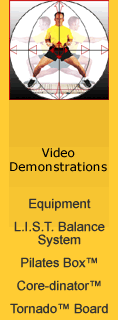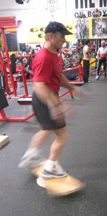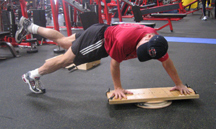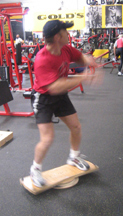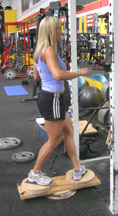|
|
Tornado™
Board
Dynamic
Rotational Kinetics |
|
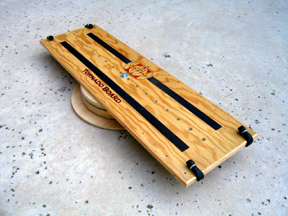
The
Tornado Board is used to create rotation around the vertical
axis to fully engage the core. This single-axle rotational device
is used to improve ambidexterity and proprioception through
the use of multiple plane, rhythmic, full-body movements.
|
The
Tornado Board
The single axial mechanism creates rotation around the
pillar of power. Note the stability of the trunk and head
as the arms and legs contribute to movement. |
By
stimulating the proprioceptive system in the transverse plane
with predictable rhythmic movements, the Tornado Board creates
a unique opportunity for the athlete to establish better overall
balance and ambidexterity. These are key elements necessary
for developing the neuromuscular skills required for optimum
performance.
Predictable,
rhythmic, ambidextrous conditioning drills and exercises are
the foundation for fluid mechanics, easy transition and smooth
recovery. As we become familiar with “contrary motion”
(e.g., right foot forward, left foot back) and the centrifugal
forces created by rhythmic rotational exercises, the body’s
kinetic chain moves towards complete integration resulting in
more fully developed proprioception.
|
The
Tornado Board
Karl List performing prone lateral trunk flexion with
single leg raise on the Tornado Board. This exercise is
great for core function and stability. |
The
320/220/180 Advantage
Variable resistance settings create three different and unique
rotational capabilities.
320-degree
Configuration
The Tornado Board produces approximately 320-degrees of rotation
around the vertical axis (160 degrees to the right, 160 degrees
to the left). This is great for improving overall balance, fluid
movement and smooth transitional skills. This free-flowing setting
creates a mind-body connection that makes us more aware of gravity
as it hyper-activates our vestibular system (much like a child
spinning in circles or the practice of tai chi).
220-degree
Configuration
With a simple adjustment in resistance, the Tornado Board will
produce approximately 220-degrees of movement (110 degrees to
the right, 110 degrees to the left) with more rapid transitions
at either end of the range. This creates greater demand on core
muscles, unifying them with the entire kinetic chain.
180-degree
Configuration
The short-range configuration adds increased resistance and
reduces the range to approximately 180-degrees (90-degrees to
the right, 90-degress to the left). This produces the skills
for rapid transitions and further increases the demand on the
core muscles and their integration with the kinetic chain. This
configuration is used to develop power and speed in the transverse
plane.
Both
the 220 and 180 settings can be used for rotational strength
exercises as well.
The
320/220/180 Advantage
Note the position of the name "Tornado Board."
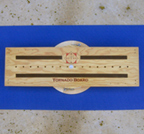 |
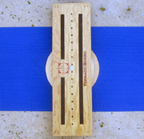 |
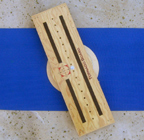 |
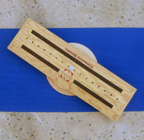 |
Neutral
Position |
180
degree rotation |
220
degree rotation |
320
degree rotation |
Benefits
and Functions
| Uses
centrifugal force and contrary motion to increase core health
and functionality |
Provides
prone lateral trunk flexion and rotational strength exercise
capabilities |
Uni-axial
rotation isolator provides up to 320-degree range of motion
to develop vertical - axis awareness |
Utilizes
predictable, multiple plane, rhythmic, full-body movements
to enhance ambidexterity and proprioception in the transverse
place |
|
Tornado
Board™ Exercises
The Tornado Board can be used to perform
standing and prone exercises. |
|
Standing
Karl List performing rotation with squat and high-low
reach on the Tornado Board. This exercise challenges and
defines the righting reflex mechanisms.
As
centrifugal force pushes out against the transverse abdominals,
they respond automatically by drawing in the gut content.
Maintaining a wide base of support and strong arch position
improves communication in the ankle, knee and hip complex
resulting in greater joint stability. |
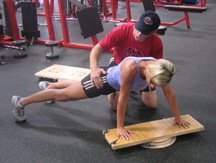 |
Prone
Pro fitness champion Theresa Hessler performing lateral
trunk flexion on the Tornado Board. Typical oblique exercises
focus on single vector stress. The Tornado Board provides
multiple-vector stress due to the prone position and the
resistance elements of the equipment. |
The
Cyclone™
Multi-Axial Rotation |
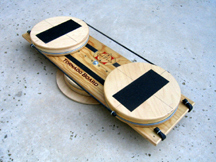 |
The
Cyclone takes the functionality of the Tornado Board to a multi-axial
dimension. By adding the rotational disks of the L.I.S.T. Core-dinator,
the Cyclone provides dynamic, tri-axial demand (Tornado Board
axle plus the rotational axles for each foot or hand) creating
stability and functionality in the major joint complexes of
the shoulders and hips.
|
Cyclone
Exercises
The Cyclone can be used to perform standing
and prone exercises. |
|
|
Standing
Theresa Hessler performing Cyclone fourth position. The
single axle of the Tornado Board demands trunk stability
while the foot disks provide multi-vector stimuli. This
stimulates the primary and secondary muscles of the pelvic
floor, promoting better pelvic position and core stability.
The contrary motion created by the device creates ambidextrous
awareness. |
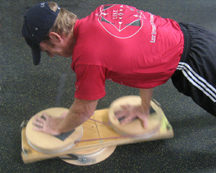 |
Prone
Karl List performing an advanced functional shoulder exercise
on the Cyclone. The single axle of the Tornado Board demands
trunk stability while the hand disks provide multi-vector
stimuli. This exercise is great for developing strong
dynamic shoulder function and a stable thorax. |
TO PURCHASE ANY OF OUR EQUIPMENT, PLEASE VISIT THE PROSHOP
The
Tornado and Cyclone are registered trademarks of List Integrated
Systematic Training, Inc.
Special
thanks to Theresa Hessler for being our fitness model. Theresa
is a Personal Trainer and Pro Fitness Champion working out of
world famous Gold's Gym in Venice, California.
return
to top
Copyright
2004 Karl List, All Rights Reserved


